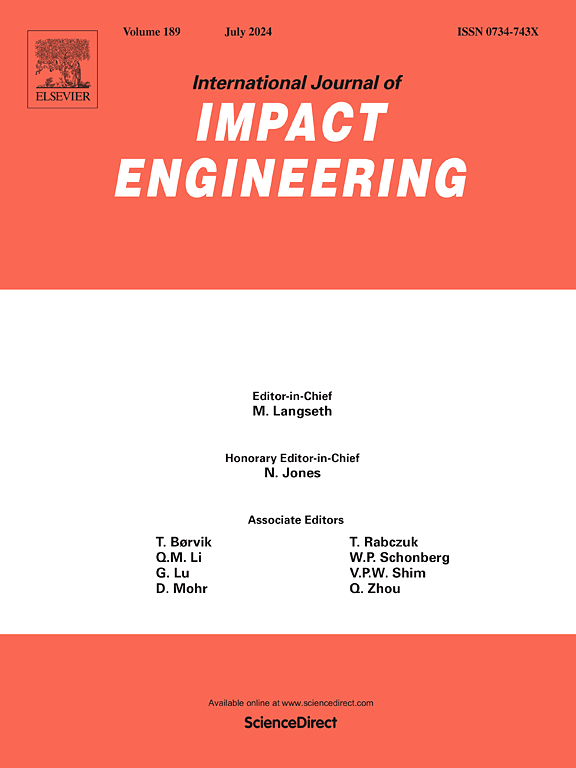Thermoplastic sandwich cylindrical structure with hierarchical honeycomb core: Dynamic/static compression and compression-after-impact behavior
IF 5.1
2区 工程技术
Q1 ENGINEERING, MECHANICAL
International Journal of Impact Engineering
Pub Date : 2025-02-24
DOI:10.1016/j.ijimpeng.2025.105289
引用次数: 0
Abstract
Sandwich cylindrical structures, appreciated for their lightweight, high specific strength, excellent energy absorption, and crash resistance, are gaining popularity in aerospace, automotive, and marine industries. Initially, these structures were mainly made of metal or thermosetting composites. Using thermoplastic composites in fabrication highlights a significant step towards better performance. However, constructing thermoplastic sandwich cylindrical structures meets some challenges due to the difficulties in joining thermoplastic composites and the limited reshaping options before curing. In this research, we develop a method that includes a snap-fit technique and a self-reinforced technique to produce thermoplastic sandwich cylindrical structures with a hierarchical honeycomb core. The snap-fit technique uses 2D chips and constructs them into a 3D structure. Additionally, a self-reinforced technique that uses rods made from the same material as the composite matrix enhances the structural connectivity without adding any extra compounds, thus keeping the structures recyclable. The mechanical properties of these sandwich cylindrical structures were evaluated using quasi-static compression, low-speed impact, and compression after impact (CAI) tests. The results show that these structures have exceptional energy absorption ability, with an average specific energy absorption exceeding 4 J/g. Most notably, after impacts of 300, 600, and 900 J, the structure's energy absorption ability and crush force efficiency were pleasantly improved. This demonstrates the difference between thermoplastic and thermoset composites. Unlike brittle fractures, the thermoplastic composite structure undergoes plastic deformation upon impact, presenting a benefit in energy absorption, especially in situations involving secondary impacts.
具有分层蜂窝芯的热塑性夹层圆柱结构:动/静态压缩和冲击后压缩行为
夹心圆柱结构因其重量轻、比强度高、吸能性好、抗碰撞性好等优点,在航空航天、汽车和海洋工业中越来越受欢迎。最初,这些结构主要由金属或热固性复合材料制成。在制造中使用热塑性复合材料突出了向更好的性能迈出的重要一步。然而,由于热塑性复合材料的连接困难以及固化前的重塑选择有限,构建热塑性夹层圆柱形结构遇到了一些挑战。在本研究中,我们开发了一种方法,包括卡扣技术和自增强技术,以生产具有分层蜂窝核心的热塑性夹层圆柱形结构。snap-fit技术使用2D芯片并将其构建成3D结构。此外,一种使用与复合材料基体相同材料制成的棒的自增强技术增强了结构的连通性,而不添加任何额外的化合物,从而保持结构的可回收性。通过准静态压缩、低速冲击和冲击后压缩(CAI)试验评估了这些夹层圆柱形结构的力学性能。结果表明,这些结构具有优异的吸能能力,平均比能吸收超过4 J/g。最值得注意的是,在300、600和900 J的冲击作用下,结构的吸能能力和抗压效率都有了较好的提高。这表明热塑性和热固性复合材料之间的区别。与脆性断裂不同,热塑性复合材料结构在撞击时发生塑性变形,在能量吸收方面具有优势,特别是在涉及二次撞击的情况下。
本文章由计算机程序翻译,如有差异,请以英文原文为准。
求助全文
约1分钟内获得全文
求助全文
来源期刊

International Journal of Impact Engineering
工程技术-工程:机械
CiteScore
8.70
自引率
13.70%
发文量
241
审稿时长
52 days
期刊介绍:
The International Journal of Impact Engineering, established in 1983 publishes original research findings related to the response of structures, components and materials subjected to impact, blast and high-rate loading. Areas relevant to the journal encompass the following general topics and those associated with them:
-Behaviour and failure of structures and materials under impact and blast loading
-Systems for protection and absorption of impact and blast loading
-Terminal ballistics
-Dynamic behaviour and failure of materials including plasticity and fracture
-Stress waves
-Structural crashworthiness
-High-rate mechanical and forming processes
-Impact, blast and high-rate loading/measurement techniques and their applications
 求助内容:
求助内容: 应助结果提醒方式:
应助结果提醒方式:


